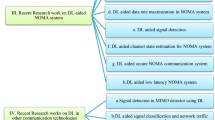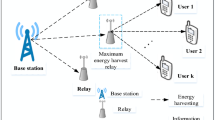Abstract
Wireless personal communication has become popular with the rapid development of 5G communication systems. Critical demands on transmission speed and QoS make it difficult to upgrade current wireless personal communication systems. In this paper, we develop a novel resource allocation method using deep learning to squeeze the benefits of resource utilization. By generating the convolutional neural network using channel information, resource allocation is to be optimized. The deep learning method could help make full use of the small scale channel information instead of traditional resource optimization, especially when the channel environment is changing fast. Simulation results indicate the fact that the performance of our proposed method is close to MMSE method and better than ZF method, and the time consumption of computation is smaller than traditional method.




Similar content being viewed by others
References
3GPP, Website Available Online: http://www.3gpp.org/release-16
del Peral-Rosado JA, Raulefs R, López-Salcedo JA, Seco-Granados G (2018) Survey of cellular Mobile radio localization methods: from 1G to 5G. IEEE Communications Surveys & Tutorials 20(2):1124–1148 Secondquarter 2018
Benchaabene Y, Boujnah N, Zarai F (2017) 5G Cellular: Survey on Some Challenging Techniques, 2017 18th International Conference on Parallel and Distributed Computing, Applications and Technologies (PDCAT), Taipei, pp. 348-353
Olwal TO, Djouani K, Kurien AM (2016) A survey of resource management toward 5G radio access networks. IEEE Communications Surveys & Tutorials 18(3):1656–1686, thirdquarter
Akpakwu GA, Silva BJ, Hancke GP, Abu-Mahfouz AM (2018) A survey on 5G networks for the internet of things: communication technologies and challenges. IEEE Access 6:3619–3647
Martin A et al (2018) Network resource allocation system for QoE-aware delivery of media services in 5G networks. IEEE Trans Broadcast 64(2):561–574
Ejaz W, Ibnkahla M (2018) Multiband Spectrum sensing and resource allocation for IoT in cognitive 5G networks. in IEEE Internet of Things Journal 5(1):150–163
Xu B, Chen Y, Carrión JR, Zhang T (2017) Resource allocation in energy-cooperation enabled two-tier NOMA HetNets toward green 5G. IEEE Journal on Selected Areas in Communications 35(12):2758–2770
Kiani A, Ansari N (2018) Edge computing aware NOMA for 5G networks. in IEEE Internet of Things Journal 5(2):1299–1306
Morgado AJ, Huq KMS, Rodriguez J, Politis C, Gacanin H (2017) Hybrid resource allocation for millimeter-wave NOMA. IEEE Wirel Commun 24(5):23–29
Caso G, Nardis LD, Benedetto MGD (2017) Toward context-aware dynamic Spectrum management for 5G. IEEE Wirel Commun 24(5):38–43
Hassan Y, Hussain F, Hossen S, Choudhury S, Alam MM (2017) Interference minimization in D2D communication Underlaying cellular networks. IEEE Access 5:22471–22484
Tang A, Wang X, Zhang C (2017) Cooperative full duplex device to device communication Underlaying cellular networks. IEEE Trans Wirel Commun 16(12):7800–7815
Ferreira PVR et al (2018) Multi-objective Reinforcement Learning for Cognitive Satellite Communications using Deep Neural Network Ensembles, in IEEE Journal on Selected Areas in Communications
Atallah R, Assi C, Khabbaz M (2017) Deep reinforcement learning-based scheduling for roadside communication networks, 2017 15th International Symposium on Modeling and Optimization in Mobile, Ad Hoc, and Wireless Networks (WiOpt), Paris, pp. 1-8
Dorner S, Cammerer S, Hoydis J, ten Brink S (2017) On deep learning-based communication over the air, 2017 51st Asilomar Conference on Signals, Systems, and Computers, Pacific Grove, CA, pp. 1791-1795
Challita U, Dong L, Saad W (2017) Proactive Resource Management for LTE in Unlicensed Spectrum: A Deep Learning Perspective, in IEEE Transactions on Wireless Communications
Challita U, Dong L, Saad W (2017) Deep Learning for Proactive Resource Allocation in LTE-U Networks, European Wireless 2017; 23th European Wireless Conference, Dresden, Germany, pp. 1-6
Lee M, Xiong Y, Yu G, Li GY (2018) Deep Neural Networks for Linear Sum Assignment Problems," in IEEE Wireless Communications Letters
Li H, Wei T, Ren A, Zhu Q, Wang Y (2017) Deep reinforcement learning: Framework, applications, and embedded implementations: Invited paper, 2017 IEEE/ACM International Conference on Computer-Aided Design (ICCAD), Irvine, pp. 847-854
Hackett TM, Bilén SG, Ferreira PVR, Wyglinski AM, Reinhart RC (2017) Implementation of a space communications cognitive engine, 2017 Cognitive Communications for Aerospace Applications Workshop (CCAA), Cleveland, pp. 1-7
AlQerm I, Shihada B (2017) Enhanced machine learning scheme for energy efficient resource allocation in 5G heterogeneous cloud radio access networks, 2017 IEEE 28th Annual International Symposium on Personal, Indoor, and Mobile Radio Communications (PIMRC), Montreal, pp. 1-7
Chen M, Saad W, Yin C (2017) Liquid State Machine Learning for Resource Allocation in a Network of Cache-Enabled LTE-U UAVs," GLOBECOM 2017 - 2017 IEEE Global Communications Conference, Singapore, pp. 1-6
Qian LP, Zhang YJ, Huang H, Wu Y (2013) Demand response management via real-time electricity price control in smart grids. IEEE Journal on Selected areas in Communications 31(7):1268–1280
Qian LP, Wu Y, Zhou H, Shen XS (2017) Joint uplink base station association and power control for small-cell networks with non-orthogonal multiple access. IEEE Trans Wirel Commun 16(9):5567–5582
Acknowledgments
This work is funded by National Nature Science Foundation of China under grant of 61701503. The author would also like to thank all the reviewers, their suggestions help improve my work a lot.
Author information
Authors and Affiliations
Corresponding author
Ethics declarations
Conflict of interests
The authors declare that there is no conflict of interests regarding the publication of this paper.
Rights and permissions
About this article
Cite this article
Huang, D., Gao, Y., Li, Y. et al. Deep Learning Based Cooperative Resource Allocation in 5G Wireless Networks. Mobile Netw Appl 27, 1131–1138 (2022). https://doi.org/10.1007/s11036-018-1178-9
Published:
Issue Date:
DOI: https://doi.org/10.1007/s11036-018-1178-9




